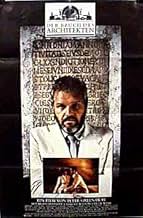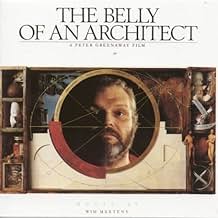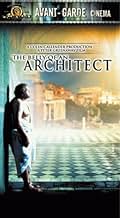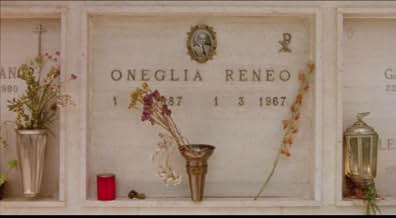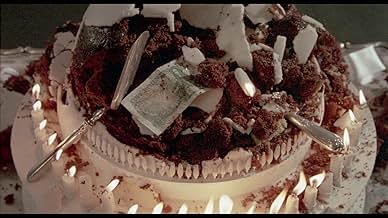NOTE IMDb
6,9/10
6,5 k
MA NOTE
Ajouter une intrigue dans votre langueAn architect supervising an exhibition starts to have mysterious stomach pains while his life slowly falls apart.An architect supervising an exhibition starts to have mysterious stomach pains while his life slowly falls apart.An architect supervising an exhibition starts to have mysterious stomach pains while his life slowly falls apart.
- Réalisation
- Scénario
- Casting principal
- Récompenses
- 2 nominations au total
Marino Masé
- Trettorio
- (as Marino Mase)
Avis à la une
Starring Brian Dennehy, an unusual actor for a Peter Greenaway film, as Kracklite, an architect, a career we don't often see explored in cinema, Greenaway's 'Belly of an Architect' is somehow bigger and more emotionally ambitious than most of his other works, which lack human resonance. In his other films, the characters are uniformly British and so Greenaway's coldness and archness toward them is indicative of a general misanthropy. Here, it's aimed squarely at Romans, whose loose morals and carnivorous practices contrast with the enormity of Kracklite's ego and generosity of spirit. His stomach is being eaten away by some unknown illness or cancer, and this serves as a metaphor for his ego being eaten away by the carnivorousness of Roman culture. His wife, his identity (which is a vicarious one, given his devotion/debt to his idol, Bouleé) and his work are being repossessed by the conquestful Roman carnivores who aim to destroy him simply for the material gain of taking what is so ostentatiously his. But his devotion to Bouleé, his need to make Bouleé's work more widely known, is not a singular or altruistic act; the exhibition he is organizing will make Bouleé more commercial and accessible, but it will also be an addendum to his own career, a manifestation of his ego. His diary is written in the form of letters to Bouleé, to whom he is almost praying as his own personal God. And his devotion to this God is not a selfless one, since Bouleé is so inexorably an element of his own identity.
Rome and its buildings are given a golden, postmodern glow, their clarity enhanced by Wim Mertens' musical score, which adds its own sunlight to the proceedings. But the sunlight that glows throughout Rome and permeates the aura of the film is an impersonal one, an indifferent one, as ancient as the ruins of Rome, which our Roman characters observe have been more useful and influential as ruins than they were prior. "They're better as ruines," a character observes. "Your imagination compensates for what you don't see, like a woman with clothes on." The Romans are depicted here as carnivores (and the word "carnivore" is used multiple times) who not only want to devour and repossess, but want to strip. Brian Dennehy's performance here is indeed stripped, larger than life, fiery. He explodes on screen, bringing the film into another realm, introducing emotional dimensions not often seen in the films of Greenaway; and in this, the film has a power that inhabits the movie's symmetrical form (mostly every shot is symmetrical), its architecture, and threatens to destroy it. The coldness that is typical of Greenaway, that architecturized godlessness, is at war with fiery human passion in all its flawed nakedness.
Greenaway's movies, in their arctic wit and obsession with symmetry, are cinema as architecture more so than storytelling, so 'The Belly of an Architect,' contrary to the claim by many that it's his most mainstream and therefore weakest work, is perhaps his most appropriate film, and maybe his best
Rome and its buildings are given a golden, postmodern glow, their clarity enhanced by Wim Mertens' musical score, which adds its own sunlight to the proceedings. But the sunlight that glows throughout Rome and permeates the aura of the film is an impersonal one, an indifferent one, as ancient as the ruins of Rome, which our Roman characters observe have been more useful and influential as ruins than they were prior. "They're better as ruines," a character observes. "Your imagination compensates for what you don't see, like a woman with clothes on." The Romans are depicted here as carnivores (and the word "carnivore" is used multiple times) who not only want to devour and repossess, but want to strip. Brian Dennehy's performance here is indeed stripped, larger than life, fiery. He explodes on screen, bringing the film into another realm, introducing emotional dimensions not often seen in the films of Greenaway; and in this, the film has a power that inhabits the movie's symmetrical form (mostly every shot is symmetrical), its architecture, and threatens to destroy it. The coldness that is typical of Greenaway, that architecturized godlessness, is at war with fiery human passion in all its flawed nakedness.
Greenaway's movies, in their arctic wit and obsession with symmetry, are cinema as architecture more so than storytelling, so 'The Belly of an Architect,' contrary to the claim by many that it's his most mainstream and therefore weakest work, is perhaps his most appropriate film, and maybe his best
I always know I can turn to Greenaway for nested worlds. He's one of few who can - not always mind, but the few occasions are precious - align the notions of image, how they project outwards to form what we know of reality - an empty field of anxious, random forces tossing us around - and the interior springwell from where these images flow out and which reveals ourselves to be in control of them. The play is usually given to us by some sort of fiction passing as real, or a charade within another, a story within itself, so that we may be directed from the confines of the narrow frame into a broader view that includes it.
The idea is especially powerful in the context of architecture, that we use form to project outwards a set of ideals but, having understood ourselves eventually circumscribed by structures that describe us, we can then use them to describe the inner landscape.
So indeed, we stroll around one such interior Rome, where earlier decadence or glory, or masks thereof, greeting us from marble balustrades and rows of pillars reflect inside. A city so ornately decorated and cast in stone, as though man would outlast his follies.
Into this comes an American architect - the man whose folly is to build things that last - to stage an exhibition for some obscure French architect who died 180 years ago. Italians are not too happy that he hasn't picked one of their own, but they oblige to finance nonetheless.
There are two broad ideas that Greenaway is careful to lightly caress, tease out their potential implications, but finally circumnavigate. The film would have been lesser had it settled on either, or is perhaps greater for encompassing both.
One is the doubling; the architect begins to imagine himself as his older counterpart, writing letters to him in the form of private confessional; then begins imagining himself as emperor Augustus, trapped in the same ploy of marital infidelity and murder. He replicates these stories around him. So these people overlap and are mirrored with bellies, bellies aching with the toll of creation. At this point you may think it is all going to be another film about the creative person losing himself in the mind, merging life with narrative.
The other is, as always with Greenaway, about all this as doubling for the making of the film. It's a film-within device, make no mistake. So the visionary artist is increasingly frustrated by lackeys, ignorant money-men, virulent antagonists scheming to usurp him; energy is wasted in duplicitous dinner parties and idle, but always more or less venomous, chit-chat, until eventually finds himself embittered and alone in his own set.
But it is not merely about the price of genius, or a satire of the contemporary civilized arena that it has to bleed into.
Look for the scene with his doctor in front of the busts of emperors; each bust a face and story, one decadent and evil, another perhaps famed as wise, but all inadvertently gone. A little further down is a bust without name, it could be anyone's, and whatever story will be inscribed upon it, it's again only destined to join this gallery of fiction. It is important to see these follies, but more important to see the continuity.
So it is this acceptance on the part of the architect, the man who builds things not only to last but to be beautiful in time, of the turn of the wheel, decline through rebirth. It is powerful stuff to see; the scene in the police station near the end, where he is simply asked name and age, whether married or not. He is free to go then. He has been jotted down in the ledgers.
The final scenes in the exhibition center echo with this casual dismissal of a life lived, a casual but sweet, relieving it would seem, departure after so much grief with nothing to weigh on the shoulders. He attends the exhibition, the work of a lifetime, from the balustrade above, from the vantage point of not being involved anymore. Everything looks like a small ceremony from there. So this is the nested world that matters; not the exhibition, but the creative life on the ego-redemptive journey through life at large, purging itself of itself, after the painful struggle to master the world building pantheons finally submitting to be the mastered world, transient, as it comes into being and goes again.
As he goes, new life is born down below - and plays, again and again it would seem, before the colossal marble structures.
It is perhaps the ideal Greenaway film; the self-referential tics are all present, the framework ornate, but instead of chaotic it is all mastered into a pillar that supports, unifies vision. The architect - on more levels than one - coming to terms with the architecture of a transient life.
The idea is especially powerful in the context of architecture, that we use form to project outwards a set of ideals but, having understood ourselves eventually circumscribed by structures that describe us, we can then use them to describe the inner landscape.
So indeed, we stroll around one such interior Rome, where earlier decadence or glory, or masks thereof, greeting us from marble balustrades and rows of pillars reflect inside. A city so ornately decorated and cast in stone, as though man would outlast his follies.
Into this comes an American architect - the man whose folly is to build things that last - to stage an exhibition for some obscure French architect who died 180 years ago. Italians are not too happy that he hasn't picked one of their own, but they oblige to finance nonetheless.
There are two broad ideas that Greenaway is careful to lightly caress, tease out their potential implications, but finally circumnavigate. The film would have been lesser had it settled on either, or is perhaps greater for encompassing both.
One is the doubling; the architect begins to imagine himself as his older counterpart, writing letters to him in the form of private confessional; then begins imagining himself as emperor Augustus, trapped in the same ploy of marital infidelity and murder. He replicates these stories around him. So these people overlap and are mirrored with bellies, bellies aching with the toll of creation. At this point you may think it is all going to be another film about the creative person losing himself in the mind, merging life with narrative.
The other is, as always with Greenaway, about all this as doubling for the making of the film. It's a film-within device, make no mistake. So the visionary artist is increasingly frustrated by lackeys, ignorant money-men, virulent antagonists scheming to usurp him; energy is wasted in duplicitous dinner parties and idle, but always more or less venomous, chit-chat, until eventually finds himself embittered and alone in his own set.
But it is not merely about the price of genius, or a satire of the contemporary civilized arena that it has to bleed into.
Look for the scene with his doctor in front of the busts of emperors; each bust a face and story, one decadent and evil, another perhaps famed as wise, but all inadvertently gone. A little further down is a bust without name, it could be anyone's, and whatever story will be inscribed upon it, it's again only destined to join this gallery of fiction. It is important to see these follies, but more important to see the continuity.
So it is this acceptance on the part of the architect, the man who builds things not only to last but to be beautiful in time, of the turn of the wheel, decline through rebirth. It is powerful stuff to see; the scene in the police station near the end, where he is simply asked name and age, whether married or not. He is free to go then. He has been jotted down in the ledgers.
The final scenes in the exhibition center echo with this casual dismissal of a life lived, a casual but sweet, relieving it would seem, departure after so much grief with nothing to weigh on the shoulders. He attends the exhibition, the work of a lifetime, from the balustrade above, from the vantage point of not being involved anymore. Everything looks like a small ceremony from there. So this is the nested world that matters; not the exhibition, but the creative life on the ego-redemptive journey through life at large, purging itself of itself, after the painful struggle to master the world building pantheons finally submitting to be the mastered world, transient, as it comes into being and goes again.
As he goes, new life is born down below - and plays, again and again it would seem, before the colossal marble structures.
It is perhaps the ideal Greenaway film; the self-referential tics are all present, the framework ornate, but instead of chaotic it is all mastered into a pillar that supports, unifies vision. The architect - on more levels than one - coming to terms with the architecture of a transient life.
Why was this film made? Because someone talked Greenaway into trying to go mainstream. By this time, he had already made some of the most adventuresome films in history. This simple confection is sandwiched between `Zed and Two Noughts' and `Drowning by Numbers,' both of which are complex, intelligent, risky, erudite.
I can only imagine that he thought he could finance his serious work with a commercial success. Some might tag this as an accessible Greenaway film, but I hardly think it is Greenaway at all. Nor is the remarkable composer Nyman present.
All that remains are some lush compositions, studies in photographing monumental architecture, and these are pleasant enough. A subtext is fascist perfidy in architecture and the film takes a critical (visual) stance on Roman architecture. See here how all the buildings are from the emperors or Mussolini. No church architecture here which must have been a conscious omission for simplicity.
Everything about the physical fabric portrayed is dehumanizing, especially as compared to the containing space of the skin. As an architect myself, I can appreciate the message. It is a clever conceit, but it pales, utterly fades away, in comparison to his best: `The Falls,' and the `book' films.
I can only imagine that he thought he could finance his serious work with a commercial success. Some might tag this as an accessible Greenaway film, but I hardly think it is Greenaway at all. Nor is the remarkable composer Nyman present.
All that remains are some lush compositions, studies in photographing monumental architecture, and these are pleasant enough. A subtext is fascist perfidy in architecture and the film takes a critical (visual) stance on Roman architecture. See here how all the buildings are from the emperors or Mussolini. No church architecture here which must have been a conscious omission for simplicity.
Everything about the physical fabric portrayed is dehumanizing, especially as compared to the containing space of the skin. As an architect myself, I can appreciate the message. It is a clever conceit, but it pales, utterly fades away, in comparison to his best: `The Falls,' and the `book' films.
The ebullient Brian Dennehy gives a fine performance as Stourley Kracklite, an American architect who is in Rome with his younger wife Louisa (Chloe Webb) to arrange an exhibition on the French architect Etienne-Louis Boullée. Kracklite is obsessed with Boullée and even writes letters to him. Kracklite's life soon begins to deteriorate. He starts to suffer excruciating stomach pains and vomits each time he eats. He even thinks that his wife is poisoning him. His wife then falls pregnant and has an affair with Kracklite's rival architect, Caspasian Speckler (Lambert Wilson). Kracklite then sleeps with Speckler's sister, to get some sort of satisfaction. Speckler intrudes while they are having sex, and announces, "having sex with your pregnant wife is perfect, because I don't need to use contraception". Kracklite then punches him on the nose. Speckler's sister then says, "Don't put your blood on my white towel."
The film follows the parallels of these two unappreciated architects from different eras. The film is memorable for Dennehy's (an actor who is also unappreciated) remarkable performance. Also, the beautiful cinematography by Greenaway's trusty DOP Sacha Vierny makes the film very easy to look at. From the ancient architecture of Rome, to a painting-like bowl of figs, it is pristine-looking. Michael Nyman is absent, but the music by Wim Mertens is splendid. This film was made in between A Zed & Two Noughts and Drowning by Numbers, and it is quite unlike those two films, which, I think, are superior to this in the way they offer us a much more enigmatic, abstract concept. But even an ever so slightly lesser Greenaway film is a thing to behold.
The film follows the parallels of these two unappreciated architects from different eras. The film is memorable for Dennehy's (an actor who is also unappreciated) remarkable performance. Also, the beautiful cinematography by Greenaway's trusty DOP Sacha Vierny makes the film very easy to look at. From the ancient architecture of Rome, to a painting-like bowl of figs, it is pristine-looking. Michael Nyman is absent, but the music by Wim Mertens is splendid. This film was made in between A Zed & Two Noughts and Drowning by Numbers, and it is quite unlike those two films, which, I think, are superior to this in the way they offer us a much more enigmatic, abstract concept. But even an ever so slightly lesser Greenaway film is a thing to behold.
Greenaway's visuals (which betray his origins as a painter in almost every gorgeously composed shot) are sumptuous. Wim Mertens score is mesmerizing. Add them to Brian Dennehy's towering performance as obsessed, betrayed, and ultimately dying American architect Stourley Kracklite and you have something very special. Kracklite is in Rome battling to put on an exhibition to his idol, 18th century French architect Etienne Louis Boulet. His young wife (Webb) betrays him, the natives scheme to undermine his exhibition and he begins to crumble physically like the ruins of the eternal city around him. The story, largely carried on Dennehy's massive shoulders, is almost incidental to the glorious, poetic footage of Rome. It is so movingly beautiful that, when I finally got around to visiting the city (a trip in no small part inspired by this film) the reality of the place couldn't compete. If you can, watch this on a big screen with the best possible suround-sound. If you can't, watch it anyway.
Le saviez-vous
- AnecdotesBrian Dennehy was quoted after the release as saying "I've made lots of movies but only one film."
- GaffesWhen photocopying the picture of Augustus, Kracklite puts the picture in upside down which would have given a blank copy (unless the same picture was on both sides). Additionally, it would not be possible to achieve the level of resolution of Augustus' abdomen from such a small picture.
- Citations
Caspasian Speckler: Your wife is very beautiful, Signor Kracklite, especially when she is pregnant.
Stourley Kracklite: Yes, that's right. She is pregnant. But not with your child, Speckler.
Caspasian Speckler: True. I'm very grateful to you for that. Your child, shall we say, is the most perfect contraceptive.
[Kracklite turns and punches Speckler in the nose]
- ConnexionsFeatured in Peter Greenaway (1992)
Meilleurs choix
Connectez-vous pour évaluer et suivre la liste de favoris afin de recevoir des recommandations personnalisées
- How long is The Belly of an Architect?Alimenté par Alexa
Détails
- Date de sortie
- Pays d’origine
- Langues
- Aussi connu sous le nom de
- The Belly of an Architect
- Lieux de tournage
- Sociétés de production
- Voir plus de crédits d'entreprise sur IMDbPro
Box-office
- Montant brut aux États-Unis et au Canada
- 287 725 $US
- Durée1 heure 59 minutes
- Couleur
- Mixage
- Rapport de forme
- 1.85 : 1
Contribuer à cette page
Suggérer une modification ou ajouter du contenu manquant

Lacune principale
By what name was Le Ventre de l'architecte (1987) officially released in India in English?
Répondre


